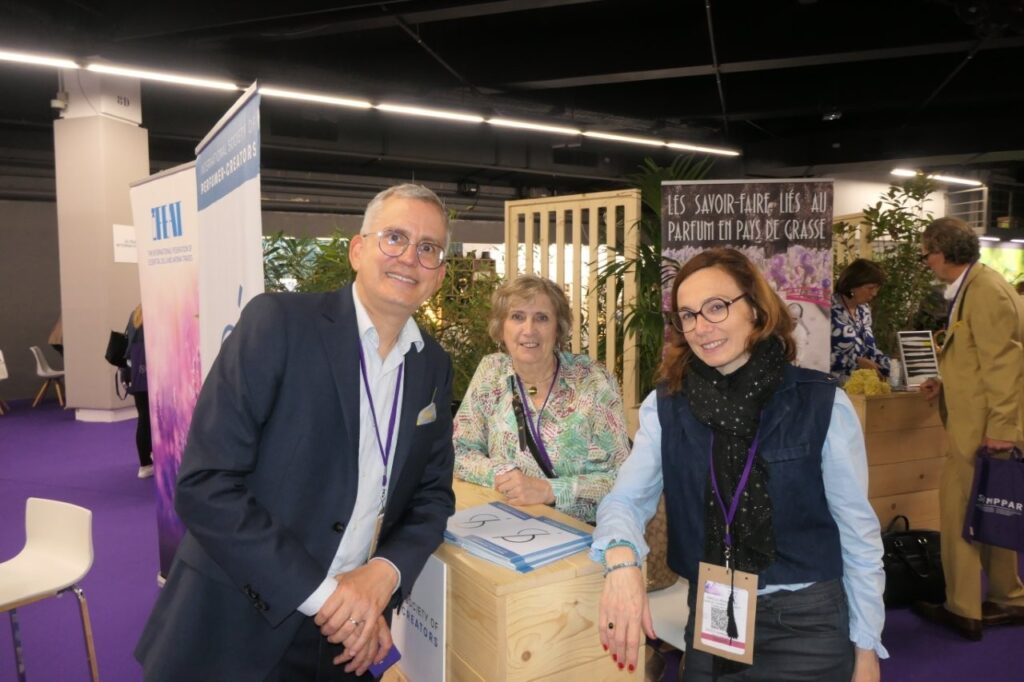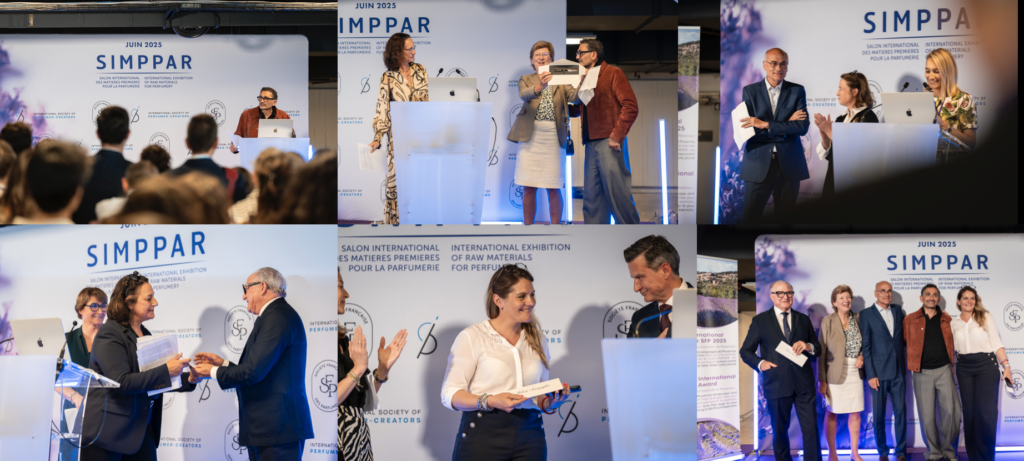Ladies and Gentlemen, dear colleagues,
Let me begin by thanking you for your warm welcome — in particular President Philippe Massé for inviting me to your General Assembly, and for the energy you bring to our industry.
As President of the ISPC — the International Society of Perfumer-Creators — I would like to speak to you today not as an institutional spokesperson, but as a creator. As a perfumer, part of a living chain of knowledge, craftsmanship, and transmission.
We stand at a turning point. The time has come to collectively ask fundamental questions about what we can still create, with which ingredient, and under what conditions.
I. A disconnected evaluation, a system at odds with cosmetic law
While it is both normal and desirable that cosmetic ingredients be assessed and regulated, the tools used for this purpose must be current, consistent with actual use, and compatible with the very nature of our craft.
Yet this is not really the case today. Most of the substances we use in perfumery are not assessed under the Cosmetics Regulation, but under REACH — the European regulation on chemicals.
REACH was introduced in 2006 to secure the use of chemical substances in European industry. A valid goal, and essential in fields such as metallurgy, automotive, electronics, construction materials or aerospace.
But let us recall that this regulation evaluates a substance in its pure form, under theoretical maximum exposure conditions, independently of real-life use.
In a cosmetic product, however, an ingredient is formulated, often diluted, sometimes encapsulated, applied locally and in minute quantities.
This is where the methodological error lies: confusing intrinsic hazard with actual risk.
This is not my own view — it is a consensus recognized by the EFSA, the ECHA, the ANSES and other European health agencies, which agree in other contexts that risk always depends on dose and exposure.
The result? Assessments based on standardized protocols that have no bearing on real consumer exposure to cosmetics.
Substances are tested via ingestion, forced inhalation, or systemic administration — sometimes at extremely high doses — with no regard for dermal exposure or the actual concentration in finished products.
But the most troubling issue lies elsewhere: to generate the data required under REACH, animal testing is still permitted — and even mandatory in some cases. At the same time, the Cosmetics Regulation strictly prohibits animal testing, both for finished products and for ingredients.
We are thus faced with a clear contradiction: what is forbidden in our sector is required in the evaluation of the substances we use. And we are then asked to defend our raw materials based on data we are neither allowed to produce nor challenge on equal terms.
Here is the first paradox: by targeting substances classified as CMR or sensitizing in their pure form, REACH directly undermines access to natural raw materials — such as lavender, for example.
And yet these materials:
- Have been used for centuries,
- Are biodegradable and non-persistent, in most cases,
- And are often sourced from agricultural sectors that are increasingly sustainable and socially committed.
Now let us take a specific example that illustrates both the inconsistency and the absurdity of the system: heliotropin, also known as piperonal — an iconic material in perfumery.
This molecule is well known for its uses in various sectors, including certain aromatic and food applications across the world.
Yet in cosmetics, where it is used topically, at typical concentrations ranging from 0.05 to 0.1% in the finished product, it is now under threat of CMR classification — based on toxicology studies carried out… via oral administration in animals.
This is not just a question of thresholds. It is a matter of methodology.
What we are questioning here is not regulatory vigilance, but the scientific relevance of the framework used to evaluate our raw materials — and above all, the legitimacy of decisions made using out-of-context data, based on protocols our sector cannot access, and sometimes even contrary to its ethical obligations.
How can one defend a substance — a creative material — if we are unable to replicate the test conditions used to condemn it, or to offer a viable regulatory alternative?
The dossier in support of heliotropin was officially submitted to the competent authorities on June 20.
This is why, on behalf of the ISPC, I urge the French authorities to take a stand during the CARACAL meeting on July 3–4, to prevent a rushed decision.
Allowing the ban to come into effect before the derogation file is reviewed would be arbitrary.
I sincerely hope that the SCCS will make its voice heard.
As for PRODAROM, it must — and can — mobilize every possible lever to carry this message forward. We are now in the final stretch.
This is not just a matter of procedure. It is a question of the survival of a language — and the transmission of a sensory heritage.
Because at its core, the problem is this: we no longer assess risk, we assess hazard — regardless of dose, exposure, or context.
And when a molecule can be condemned solely for its potential toxicity, with no regard for how it is actually used, we move from the realm of science into the realm of permanent suspicion.
II. Dupes: the erasure of the author
Speaking now as a perfumer-creator, I would like to address another issue — perhaps more economic, but no less frustrating. I’m talking about the spread of “dupes”: industrial imitators who recreate perfumes without artistic intention, without authorship, but with strong commercial impact.
This effectiveness is amplified by influencers and fragrance youtubers who have — whether we like it or not — become real taste-makers.
A “dupe” only exists because an original exists.
These practices do more than imitate: they erase. They trivialize olfactory creation by replicating its effects while denying its uniqueness. They are ersatz works. Simulacra.
Dupes are not a legal category in themselves, but in practice they can fall under several existing definitions:
- Counterfeiting, if a protected element (such as a trademark or visual) is copied or used illegally;
- Unfair competition, if the imitation creates confusion or diverts customers;
- Parasitism, when a company free-rides on the reputation or investment of another, without effort of its own.
The French Court of Cassation and the Court of Justice of the European Union have both ruled that:
A fragrance cannot be protected under intellectual property rights, because its perception is subjective, varies from person to person, and the criteria for originality cannot be objectively assessed.
Despite repeated attempts, no legal precedent has yet recognized a perfume as a work eligible for copyright.
Ultimately, this points to a deep failure of recognition.
III. A vulnerable creation, lacking legal status
We are caught in a legal grey area.
On one side: essential raw materials are disappearing. On the other: copies are multiplying.
And in between, an author without status — because perfumery is still excluded from the category of “intellectual works” in the eyes of the law.
It is seen as technical, functional, decorative.
Yet a perfume can be as structured, as intentional, and as personal as a musical score or a literary work.
It too deserves protection.
IV. What we stand for
As President of the ISPC, I would like to assert here the three key priorities we are actively pursuing:
1. The reasoned defense of our creative palette.
Not to place everything under a glass bell, but to preserve the materials that form the structure of our olfactory language.
Without them, no style. Without style, no author. And without authors… no future for perfumery as an art form.
Without these raw materials, we lose a centuries-old heritage.
2. Recognition of perfume as a work of the mind, and of the perfumer as an author.
This requires legal, cultural, and institutional work to shift perceptions.
3. A revision of the regulatory framework, particularly regarding CMR substances and allergens,
so it reflects real-world use and relevant exposure — no longer relying solely on testing disconnected from the cosmetic context.
Conclusion
This fight is not corporatist. It is cultural.
It’s not about defending a privilege — it’s about protecting a form of sensory intelligence, of human expression, that belongs in the living heritage of Europe.
The ISPC will do its part in this work.
And I call on all of you — producers, formulators, safety assessors, manufacturers — to join forces with us.
Because the freedom to create, and the protection of our heritage, are not granted.
They must be defended.
Thank you.
Thierry Wasser
ISPC President






